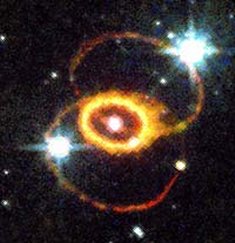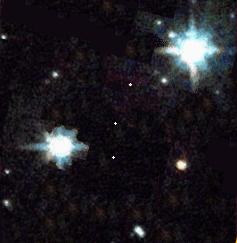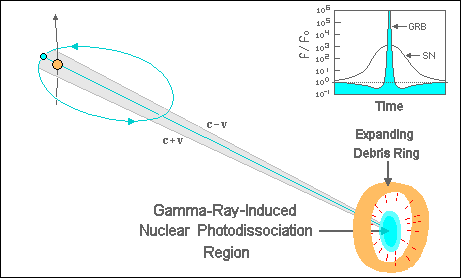
SNR 1987a HST

Hypothetical Event Sequence Animation
(Under construction!)
|
SN 1987a as a Possible Ritzian SystemInstalled 29 Jun 2007. Latest Update 25 Mar 2019.Changes or additions are in bold.
|

SNR 1987a HST |

Hypothetical Event Sequence Animation (Under construction!) |
|
The star responsible for SN 1987a is thought to be located in the Large Magellanic Cloud (163,000 LY distant). The fact that the rings of the Triple-Ring Nebula have different centers may be explained by their source being a member of a multiple star system (most likely a triplet), and as such it has been moving in it's orbit to furnish new loci for the sequence of expanding rings. For a highly elliptical orbiting binary, where Ritz/de Sitter post perihelion c+v light catches up with pre-perihelion c-v light, there can be a spike of ultra-high energy gamma radiation, coincident with the peak of what looks like a supernova explosion, which can photodissociate the majority of the heavier nuclei in the catch-up region. Protons, neutrons, and electrons (the primary photodissociation products) will speed out of this region in all directions. (This process will essentially be a diffuse nuclear explosion.) In a nutshell, the Ritz/de Sitter arrival time modulation can cause a large percentage of the starlight which has been normally emitted during a sizable fraction of the orbit period (This would correspond to the arc near perihelion that bounds the extended shaded wedge in the diagram.) to be compressed in a few tens of seconds. That time compression produces extremely high frequencies and energies.

The semi-spherical shock wave is produced when the exiting particles collide with atoms in the gas surrounding the the zone of nuclear photodissociation. The zone centroid will be on the line-of-sight between the progenitor and us as observers. Distance wise, it should be located on the order of a fraction to a few light seconds from the progenitor and the border of its cross-section should be elliptical. An event related to the diffuse nuclear explosion mentioned above may have occurred in our solar system on May 10-11, 1999. In that event the gamma radiation would have been supplied by a Gamma-Ray Burst. See the article GRB 990510 and a Solar Wind Problem and the poster GRB 990510.
Related Articles"The Triple-Ring Nebula: Fingerprint of a Binary Merger (or Supernova 1987A: a Mystery Solved)" - Philipp Podsiadlowski (Oxford), Natasha Ivanova (CITA), and Thomas Morris (Oxford/MPA). Shows a mainstream astrophysics version for the proposed axi-symmetric relation between the "physically distinct rings" of the Triple-Ring nebula. [Link was changed on 17 Sep 2014.] Kikuchi, Sheishi, "The Photodissociation of the Deuteron by High Energy Gamma-Rays," Phys. Rev., 85, 1062-1063 (1952) - NADS Kikuchi, Sheishi, "Nuclear Photodissociation by High Energy Synchrotron Gamma-Rays," Phys. Rev., 86, 41-51 (1952) - NADS X-ray light curve of SN 1987a NASA's HEASARC: Education & Public Information |